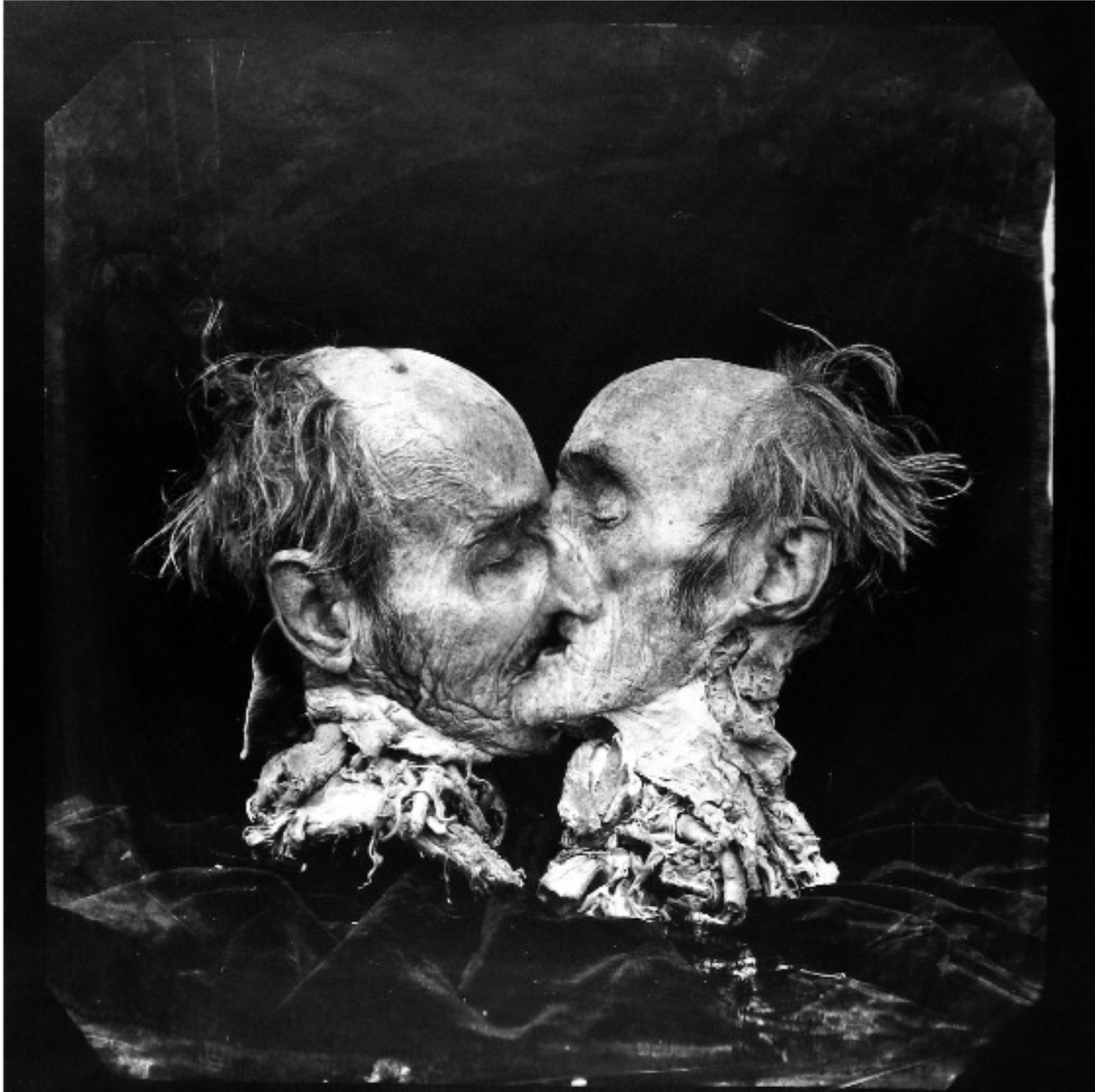Joel-Peter Witkin
Have you heard of Joel-Peter Witkin? It seems that this artist served as a source of inspiration for Alexander McQueen, influencing the creation of some of his most iconic looks. In the following article, we will explore Joel-Peter Witkin’s captivating world, delving into potentially unsettling subjects and navigating the shadows of death through his distinctive photographic lens.
Joel-Peter Witkin, Harvest Philadelphia (1984)
Joel-Peter Witkin is an American photographer whose work is simultaneously grotesque and absurd, yet undeniably fascinating and captivating at the same time. His work celebrates and honors differences, bodies, life, and death, mostly focusing on the themes of death, corpses, and dismantled body parts. He also captures the diverse physicalities of individuals, including those with dwarfism, transgender and intersex people, or those with unique physical features. Although some of these subjects can be triggering, Witkin handles his work with respect, all done in a thought-out artistic manner, often drawing inspiration from literature, religious stories, or famous artworks. Even before formal art studies, Witkin dedicated himself to photography by enlisting in the United States Army in 1961 with the intention of becoming a war photographer during the Vietnam War. Due to unforeseen circumstances, he had to spend his military service in Texas where he mostly worked on Public Information and classified photos - his work included recording the bodies of dead soldiers - and in 1967 he became the official photographer for City Walls Inc. It was not until 1974 that he received a bachelor’s degree in sculpture from Cooper Union in New York and later a master’s degree in photography and art history from the University of New Mexico in Albuquerque. It seems that his life is surrounded by death even from his birth. Born as one of triplets, his sister sadly passed away before birth, leaving only two boys. Witkin attributes his artistic inspiration to an early childhood memory at the age of six when he witnessed a decapitated girl involved in a tragic accident. Recalling the incident, he expressed, “I bent down to touch the face, to speak to it – but before I could touch it, someone carried me away.” In addition to these personal experiences, Witkin draws influence from his favorite artists, early masters, family, and the time he spent in the army. His creative focus lies in embracing “the other,” which includes marginalized groups often cast aside by society. This approach prompts viewers to question the norms of normality. His work is controversial, morbid, gruesome, and grotesque, as he fearlessly tackles dark subjects that boldly challenge fundamental societal norms and basic sensibility. Witkin takes great pride in his artistic technique, maintaining a commitment to traditional methods. He continues to use a twin-lens camera from the 1960s with conventional film rolls, deliberately avoiding the use of computers in his creative process. His dedication to traditional practices is evident in his embrace of toning and bleaching in print, as well as his hands-on approach to scraping negatives and employing chemical printing techniques. This distinctive approach sets his work apart from that of other photographers, both in its reliance on traditional methods and the nature of its content.
Witkin’s work was the main inspiration behind Alexander McQueen’s famous Spring/Summer 2001 collection, specifically the work titled Sanitarium. The collection, characterized by avian and religious imagery, plays on McQueen’s spiraling mental health, unhappiness, haunting and harsh portrait of nature, the human spirit, and the “dark side” of the fashion industry.
From Alexander McQueen Spring/Summer 2001. Courtesy of GATA magazine.
The show’s finale, however, stole the spotlight: a sound of the heartbeat filled the room before everything went dark; once the lights were turned on, the heartbeat flatlined; then, the central floor opened up revealing a figure of a Venus-like, nude woman - fetish writer Michelle Olley - wearing a rubberized cement breathing mask, reclined on a chaise longue, covered in live moths. The look, obviously referencing Witkin’s Sanitarium, was mesmerizing and refreshing after watching a show of high fashion. Olley remarked: “My body’s going to be so at odds with the fashion sparrows and bony old crow-people in the audience...I am what most of them fear most – fat”. The finale was not only meant to clash with the visuals of the toxic fashion industry and its high standards but also to force the viewers to question the true essence of beauty.
Joel-Peter Witkin, Sanitarium (1983)
But this was not the first time McQueen used Witkin as an inspiration. Back in 1996, the famous crucifix mask featured in the “Dante” show was another reference as Witkin wore the same mask in one of his self-portraits created in 1984. While McQueen did not explicitly incorporate references to Witkin’s works in later shows, he persisted in producing dark, powerful, and provocative pieces until his death. It is possible that the inspiration derived from Witkin’s photographs continued to shape McQueen’s artistic vision in later creations. One of his best-known works, a gelatin print titled Le Baiser (The Kiss, 1983) —which sold at auction for $50,000 in 2009 —depicts two severed heads twisted into a kiss. His photographs can be found at the Museum of Modern Art in New York, the J. Paul Getty Museum in Los Angeles, the National Gallery of Art in Washington, D.C., the Victoria and Albert Museum in London, and the Centre Pompidou in Paris. One of Witkin’s most renowned works is a gelatin print titled Le Baiser (The Kiss, 1983), which gained significant attention by selling at auction for $50,000 in 2009. This piece features two severed heads intricately twisted into a kiss. His impactful photographs are prominently featured in esteemed art institutions worldwide. His works can be found in the collections of the Museum of Modern Art in New York, the J. Paul Getty Museum in Los Angeles, the National Gallery of Art in Washington, D.C., the Victoria and Albert Museum in London, and the Centre Pompidou in Paris.
Joel-Peter Witkin, The Kiss (1983)





